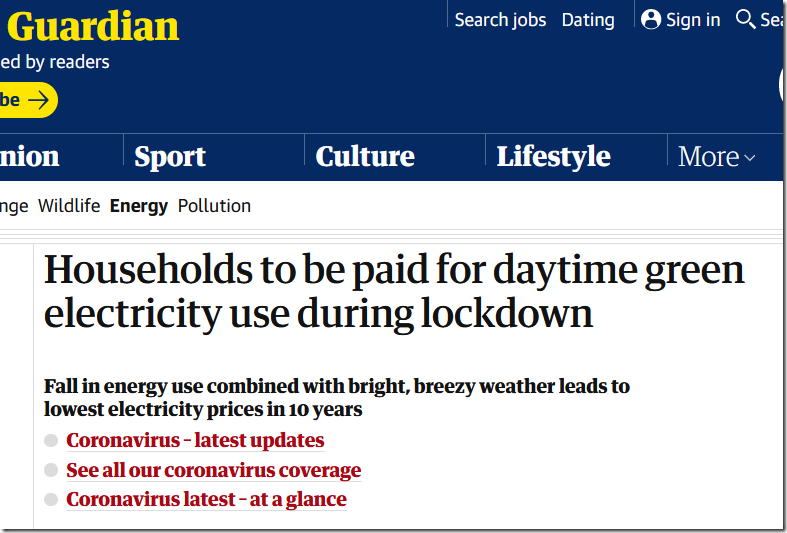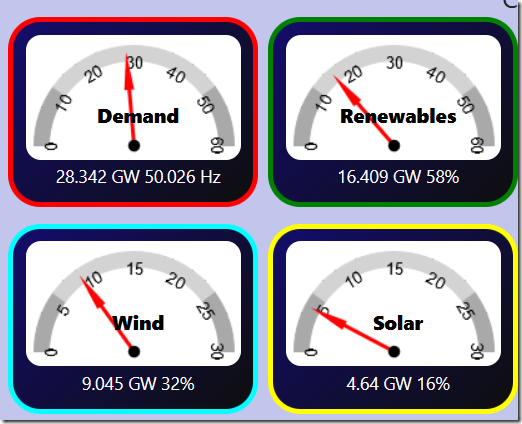Free electricity? What’s not to like!
But, of course, wind and solar power are not really free at all, as they receive obscene subsidies, paid through everybody’s energy bills. Without these subsidies, there would be no “negative electricity prices”.
APRIL 6, 2020tags: wind powerBy Paul Homewood
Thousands of British homes will be paid to use electricity during the day for the first time, as wind and solar projects produce a surge in clean energy during the coronavirus lockdown.
On Sunday morning, windfarms contributed almost 40% of the UK’s electricity, while solar power made up almost a fifth of the power system. Fossil fuels made up less than 15% of electricity, of which only 1.1% came from coal plants.
Meanwhile, the country’s energy demand has fallen by around 10% due to the shutdown of pubs, restaurants, companies and factories across the country, leading to the lowest electricity market prices in 10 years.
Households on a new breed of home energy tariff will even be paid to use electricity during the day on Sunday, because sunny weather and a brisk breeze will help generate ample clean electricity to meet the UK’s lower energy needs.
The so-called “negative electricity prices” have previously only been available to homes overnight, when demand is typically at its lowest. But the impact of the coronavirus lockdown and the bright spring weather mean some homes will be able to earn money while using clean electricity during the day for the first time.
Households which use the Agile Octopus energy tariff, offered by Octopus Energy, were contacted on Saturday to let them know they would be paid for every kilowatt hour (kWh) of electricity they use during the sunniest hours of Sunday afternoon.
From 11am-4pm, those customers will earn 0.22p-3.3p per kWh to make use of the UK’s abundant clean energy, the company said.
Free electricity? What’s not to like!
But, of course, wind and solar power are not really free at all, as they receive obscene subsidies, paid through everybody’s energy bills. Without these subsidies, there would be no “negative electricity prices”.
Currently, wind and solar are contributing 9 GW and 4 GW, respectively.
Solar farms are subsidised via the Renewable Obligation mechanism, on average receiving 1.46 ROCs for every MWh. ROCs are currently valued at £48.78, so every MWh receives a subsidy of £71.20, on top of the market price of the electricity sold.
Onshore wind accounts for about half of total wind power, and again is nearly all subsidised through ROCs, at a rate of 1.0 ROC per MWh, thus being paid a subsidy of £48.78/MWh.
Older offshore wind farms, which account for half of the total offshore market, are also on ROCs, equating to a subsidy of £92.68/MWh. Newer ones receive subsidies by Contracts for Difference, which guarantee payments of up to £173/MWh for every unit sold.
According to the Guardian, wholesale electricity prices have dropped to £28/MWh, as a result of falling gas prices and lower demand. But instead of benefitting from lower market prices, energy users are forced to carry on paying these exorbitant amounts to renewable operators.
As we discovered with EU butter mountains and wine lakes, subsidies simply distort markets and encourage over production. And as with those butter mountains, somebody has to pay the price.
- Forums
- Science & Medicine
- This is why Climate Activists will never boycott fossil fuels. They are HYPOCRITES!
Free electricity? What’s not to like! But, of course, wind and...
- There are more pages in this discussion • 380 more messages in this thread...
You’re viewing a single post only. To view the entire thread just sign in or Join Now (FREE)










